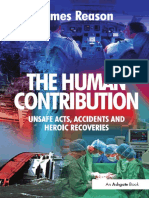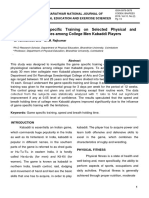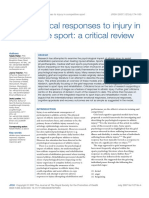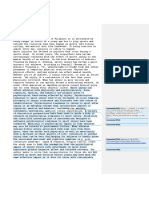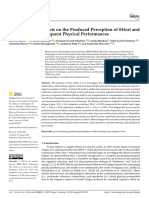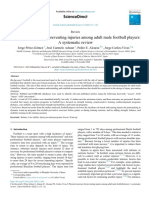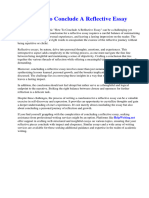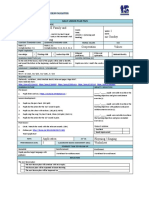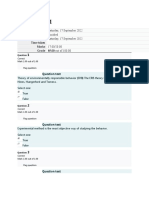Professional Documents
Culture Documents
Evaluation of Self-Efficacy, Physical Activity Participation and Return To Sports For An ACL Injury in Indian Male Athletes
Evaluation of Self-Efficacy, Physical Activity Participation and Return To Sports For An ACL Injury in Indian Male Athletes
Original Title
Copyright
Available Formats
Share this document
Did you find this document useful?
Is this content inappropriate?
Report this DocumentCopyright:
Available Formats
Evaluation of Self-Efficacy, Physical Activity Participation and Return To Sports For An ACL Injury in Indian Male Athletes
Evaluation of Self-Efficacy, Physical Activity Participation and Return To Sports For An ACL Injury in Indian Male Athletes
Copyright:
Available Formats
Volume 8, Issue 7, July – 2023 International Journal of Innovative Science and Research Technology
ISSN No:-2456-2165
Evaluation of Self-Efficacy, Physical Activity
Participation and Return to Sports for an ACL
Injury in Indian Male Athletes
1 2
Dr. Ashishdev Gera (PT) Dr. Monika Awasthi (PT)
1 2
Assistant Professor Department of Physiotherapy Pysiotherapist,
Dolphin (PG) Institute of Biomedical & Natural Sciences Male District Hospital, Balrampur
3
Dr. Shivangi Gupta (PT)
3
MPT student of Department of physiotherapy
Dolphin (PG) Institute of Biomedical & Natural Sciences
Abstract:- Keywords:- Self-Efficacy, Physical Activity and ACL-Injury.
Background: - I. INTRODUCTION
Self-efficacy is an individual’s confidence on their
ability to perform a specific task and key internal Self-efficacy refers to an individual's confidence in his
motivational process that can be affected by personal or her ability to perform a specific task or behavior to
and environmental variables and it influences achieve the successful completion of a desired outcome1.
motivational outcomes of choices efforts and goals.
According to Bandura theory, efficacy expectations
Purpose: - determine how much effort people will expend and how
To find out the subject’s self- efficacy at grade 2(2 long they will persist in the face of obstacles and aversive
and 3 months) and grade 3(2 and 3 months) of ACL experiences. The stronger the perceived self-efficacy, the
injury and find out correlation the K-SES with the more active efforts.
subjective scales (physical activity, age and return to
sports). Self-efficacy expectations vary on several dimensions
they differ in magnitude, generality and strength2.
Materials and Methods: -
25 subjects (16-35) of each grade 2 and grade 3 of Self-efficacy in subjects with ACL injury measured by
ACL injury (2 and 3 months) confirmed by MRI will instrument K-SES is found reliable and valid so, it makes
filled questionnaires form at 2 and 3 months from ACL easier to study the responsiveness of the K-SES and various
injury. Subjects completed six scales i.e., Marx scale, aspects of self-efficacy in the ACL population 3.
KOOS scale, K-SES scale, Lysholm scale, Tegner scale
and ACL-RSI scale. Analyzed using IBM SPSS 19. T-test The original K-SES is used to identify patients with
was used. P-value <0.05 was considered significant. high self-efficacy as well as subjects with low self-efficacy
from early after ACL injury and ACL reconstruction up to
Results: - 12 months thereafter 4.The anterior cruciate ligament (ACL)
Grade 2 and 3 of 2 and 3 months shows not is officially injured during sports activities, mostly after
significant, shows only differences because of jumping, changing direction, running, sudden stoppage and
psychosocial and psychological factors, correlation seen overextended of lower leg5.Adolescent age group affects
self-efficacy on physical activity, return to sports and age more and increases the incidence rate of ACL Injury7.
of grade 2 and 3 it not shows significant because of
coping strategies and quality of life, less time duration. According to Bandura (1986) and researchers have
shown that self-efficacy is a key internal motivational
Conclusions: - process that can be affected by personal and environmental
Self- efficacy, physical activity participation and variables it inflences motivational outcomes of choices
return to sport for an ACL injury in Indian male efforts and goals10.
athletes does not show significance because of internal
and external risk factors as observed in this study for The psychosocial factors include cognitive, affective
Indian male athletes. The differences show self-efficacy and behavioral factors which play important roles in the
in grade 2(2 and 3 months) and grade 3(2 and 3 months) recovery from an ACL injury so, all three factors are
of ACL injury because of psychosocial, psychological particularly important for roles in the outcome of the injury.
factors and environmental factors. these three factors have several components like
IJISRT23JUL216 www.ijisrt.com 572
Volume 8, Issue 7, July – 2023 International Journal of Innovative Science and Research Technology
ISSN No:-2456-2165
interpretations, appraisals and beliefs that come under Criteria:-
cognition, it concerns the conscious assessments athletes
make after an injury. affective factors include emotions, Inclusion Criteria: -
feelings and mood disturbances. furthermore, the behavior Suspected ACL injury and ACL deficient,16-35 years
of the athletes refers to someone's effort, actions, and of age athlete, Injured before one or two months before,
activities about an injury9. Able to read and understand the English language,
Unilateral ACL injury, Grade 2 and Grade 3 of ACL injury
After the injury, athletes usually report anger, confirmed by consulted doctor through MRI.
depression, anxiety, a lack of confidence and fear of
sustaining a reinjury so, there is evidence that these Exclusion Criteria: -
psychological disturbances may affect recovery and Bilateral ACL injury, Previous ACL surgery, Cartilage
returning to sport and also increase the risk of sustaining a Injury requiring surgery, Multiple ligament reconstruction,
reinjury6. For example, after injury recreational athletes Questionnaire data were in complete, ACL reconstruction.
were found to experience lower mood disturbances than
competitive athletes and were slower to recover Outcome Measures
psychosocially8. Knee pain, Physical activity, Knee function, Knee
symptoms, Self-efficacy, Daily activities, Quality of life,
Recovery after sports injury is influenced not only by Psychological readiness to return to sport.
physical factors but also by psychological factors.
Therefore, successfully transition back to the sport after Operational Definition
injury Athletes need to be physically as well as
psychologically ready6. It means for return to sports both Self-Efficacy: -
factors are important physical as well as psychological Self-efficacy refers to confidence in one’s abilities to
factors. successfully perform a particular behavior. Self-efficacy was
introduced in 1977 by Albert Bandura11.
The most common psychological issues athletes face is
fear of reinjury, concerns about the inability to perform at Physical Activity: -
the previous level, feelings of isolation, lack of athletic WHO defines physical activity as any bodily
identity, insufficient social support, and pressure to return to movement produced by skeletal muscles that requires
sport and this puts negative influences on the rehabilitation energy expenditure. Physical activity refers to all movement
of an ACL injury. ACL rehabilitation requires a minimum including during leisure time, for transport to get to and
of 6 months of physical therapy before returning to sport8. from places, or as part of a person’s work12.
Patients' positive psychological responses are more ACL Injury: -
likely to have better rehabilitation outcomes, as having less An ACL injury was defined as a partial or complete
fear and anxiety is positively correlated to returning to rupture of the ligament that occur for the first time or as a
sport7.Apply self-efficacy education and its role on recurrence. The ligament injury could occur in isolation or
rehabilitation in improving physical activity participation in combination with another knee joint injuries13.
and return to sports if some differences seen in grade 2 and
grade 3 of 2 and 3 months respectively.To find out the II. REVIEW OF LITERATURE
subject’s self-efficacy at grade 2 (2 and 3 months) and grade
3 (2 and 3 months) of ACL injury and find out correlation (2019) Takuya kitaguchi et al in their study
the K-SES with the subjective scales including physical “Importance of functional performance and
activity, age and return to sport. psychological readiness for return to preinjury level of
sports 1 years after ACL reconstruction in competitive
Hypothesis athletes” concluded that in competitive athletes, SLH<81%
and ACL-RSI<55points at 6 months after surgery were
Alternate Hypothesis: - Self-efficacy, physical activity associated with a greater risk of unsuccessful RTS at 1 year
participation and return to sport for an ACL injury in after surgery. SLH and ACL-RSI at 6 months could serve as
Indian male athletes show significance. screening tools to identify athletes who have difficulties
Null Hypothesis: - Self-efficacy, physical activity with returning to sports after ACL reconstruction.
participation and return to sport for an ACL injury in
Indian male athletes does not show significance. (2021) Christopher kuenze et al in their study
“Assessing physical activity after ACL injury: Moving
Sample Size: - beyond return to sport” concluded that in clinicians and
researchers have relied on return to sport status or self-
Number of Subjects: - 50 reported PA participation via surveys. These approaches are
Sources of Subjects: -Pavilion ground Dehradun and not consistent with current recommendations for PA
Maharana Pratap sports college Dehradun. assessment and do not allow for comparison with
Study Design: -Cohort study. contemporary PA recommendation and guidelines. Return to
Sampling Method: - Judgmental or purposive sampling sport, patient reported outcome measures, and device-based
IJISRT23JUL216 www.ijisrt.com 573
Volume 8, Issue 7, July – 2023 International Journal of Innovative Science and Research Technology
ISSN No:-2456-2165
assessment approaches should be used in complementary return to acceptable levels of physical activity, symptoms
manners to comprehensively assess PA participation after and muscle function 1 year after ACL reconstruction.
ACLR. However, appropriate techniques should be used
when assessing PA in adult and adolescent populations. (2016) Clare Ardern et al in their study “Satisfaction
with knee function after primary anterior cruciate
(2005) P. Thomeé et al in their study “A new ligament reconstruction is associated with self-efficacy,
instrument for measuring self- efficacy in patients with quality of life, and returning to the preinjury physical
an anterior cruciate ligament injury” concluded that good activity” concluded that people who had returned to their
reliability and good face, content, construct and convergent pre-injury physical activity, and reported higher knee-related
validity were demonstrated for this new instrument (K-SES) self-efficacy and quality of life were more likely to be
for measuring perceived self-efficacy in patients with an satisfied with the outcome of ACL reconstruction.
ACL injury. The K-SES is recommended for studied
designed to evaluate prognostic and outcome expectations of (2019) Kate E. Webster et al in their study
perceived self-efficacy in patients with an ACL-insufficient “Expectations for return to preinjury sport before and
knee. after anterior cruciate ligament reconstruction”
concluded that patients had high expectations for returning
(2013) Roland Thomeé et al in their study “Return to to their preinjury level of sport at the time of undergoing
sports after anterior cruciate ligament reconstruction in initial ACLR. Expectations were lower for those who had
women” concluded that women who successfully returned undergone previous ACLR. Female patients and patients
to their pre-injury sports activity, had, in the early who had undergone previous ACLR were more likely to
postoperative tests a higher physical activity, a higher change their expectations and cease sport participation.
physical activity, a higher goal for their future physical These data can be used to provide patients with realistic
activity, lower pain and symptoms, better knee function, a return-to-sport expectations in the first postoperative year
higher knee related quality of life and a higher LSI and highlight the challenge for patients who aim to return
compared with those women that did not return. from multiple ACL injuries.
(2007) P. Thomeé et al in their study “Self-efficacy, III. PROCEDURE
symptoms and physical activity in patients with an
anterior cruciate ligament injury: a prospective study” Subjects of Grade 2 & Grade 3 confirmed by the MRI
concluded that K-SES has good responsiveness with with ACL injury will filled Questionnaires form at 2 months
significantly increased self-efficacy during the rehabilitation and 3 months from ACL injury will be recruited from sports
process for patients with an ACL-deficient knee as well as academy as per inclusion and exclusion criteria. Explanation
for patients who had undergone ACL reconstruction. The will be done regarding the study. Subjects completed the six
improvement in perceived self-efficacy could, however, scales i.e, Marx scale, KOOS scale, K-SES scale, Lysholm
only be partly explained by the improvement in subjective scale, Tegner scale and ACL-RSI scale.
symptoms. Furthermore, self-efficacy differed significantly
with gender, age and physical activity level early in the Marx scale includes 4 items: frequency of running,
rehabilitation process. cutting, deceleration and pivoting subjects based on the
“healthiest and most active state in the past year”. It
(2022) Ojoawo Adesola Ojo et al in their study emphasizes high level knee function of functional activities.
“Relationship among self- efficacy, physical activity and Total score is obtained by adding the individual items score
beliefs in patients with knee osteoarthritis” concluded range 0-16, where 0=less time in a month and 4=4 or more
that majority of the respondents had a high general self- time in a week14.
efficacy. There was a significant but inverse relationship
between self-efficacy and each of pain self-efficacy and KOOS scale assess short and long relevant outcome
belief among patients with knee osteoarthritis. following knee injury. It has five outcomes: pain (5 items),
symptoms (7 items), activity of daily living (17 items), sport
(2010) Pia Thomeé et al in their study “A and recreation function (5 items), and knee related quality of
Randomized, controlled study of a rehabilitation model life (4 items), where 0=no problem and 4= extreme problem
to improve knee-function self-efficacy with ACL injury” and each of the 5 scores is calculated as the sum of the items
concluded that there was no evidence that the clinical included15.
rehabilitation model with strategies to enhance self-efficacy
resulted in a better outcome than the rehabilitation protocol K-SES scale consists of 22 items it assesses self-
used for the control group. efficacy in daily activity (7 items), sports and leisure
activities (5 items), physical activity (6 items) and knee
(2007) Pia Thomeé et al in their study “Self-efficacy function in future (4 items). K-SES scale have 2 factors: 1st
of knee function as a pre-operative predictor of outcome factor refers self-efficacy related to present functioning and
1 year after anterior cruciate ligament reconstruction” 2nd factor refers to knee function in the future. Items are
concluded that patients’ perceived self-efficacy of knee scored on an 11 points scale 0=not certain and 10= very
function pre-operatively is of predictive value for their certain16.
IJISRT23JUL216 www.ijisrt.com 574
Volume 8, Issue 7, July – 2023 International Journal of Innovative Science and Research Technology
ISSN No:-2456-2165
Tegner activity level scale describes their current ACL-RSI measures psychological readiness to return
activity level and that before injury. Scores varies 0-10 to sport after an ACL injury score of each category were
where, 0=sick leave or disability pension because of knee added and average the total score between 0 to 100 points
problem and 10= participation in nation and international where higher points indicates greater psychological
elite competitive sports17. readiness to return to sport18
Lysholm scale assess a subject knee specific symptom. Before collecting data, individual consent was taken
Maximum score is 100 points where, 91-100 is excellent, along with demographic data.
84-90 is good, 65-83 is fair, 64 or less is unsatisfactory17.
IV. ESTIMATED TIME NEEDED FOR DATA COLLECTION (THREE MONTHS)
Result:-
Table 1 For Grade-2, Compare in between 2 Months & 3 Months
Grade-2 Grade-2
Mean Value 2 months 3 months x-y D D2 V SD
Age 19.4 19.4 0 2 0 0 0
ACL RSI 620.8 792.8 172 2 29584 1232.667 35.10935
Marx Scale 12.96 6.44 6.52 2 42.51 1.77125 1.330883
K-SES Intrument
Daily activities 42.16 12.12 30.04 2 902.41 37.60042 6.131918
Sports & Leisure activities 6.32 4.32 2 2 4 0.166667 0.408248
Physical activities 43.76 19.32 24.44 2 597.31 24.88792 4.988779
Knee function in the future 16.6 13.6 3 2 9 0.375 0.612372
Lysholm knee Score 69.56 85.16 15.6 2 243.36 10.14 3.184337
Tegner Activity Score
Activity level before injury 9.56 8.72 0.84 2 0.71 0.029583 0.171998
Current activity level 7 6.88 0.12 2 O.014 0.006 0.0007
KOOS
Pain 10.52 2.72 7.8 2 60.84 2.535 1.592168
Symptom 13.08 7.84 5.24 2 27.45 1.14375 1.069462
Functional Daily Living 8.92 2.72 6.2 2 38.44 1.601667 1.26557
Function, Sports & Recreational activities 8.64 3.2 5.44 2 29.59 1.232917 1.110368
Quality of Life 7.48 3.64 3.84 2 14.74 0.614167 0.783688
Table 2 For Grade-3, Compare in between 2 Months & 3 Months
Grade-3 Grade-3
Mean Value 2 months 3 months x-y D D2 V SD
Age 20.92 20.92 0 2 0 0 0
ACL RSI 610 707.6 97.6 2 9525.76 396.9067 19.92252
Marx Scale 6.04 8.2 2.16 2 4.67 0.194583 0.441116
K-SES Intrument
Daily activities 51.16 45.12 6.04 2 36.48 1.52 0.073
Sports & Leisure activities 2.68 3.24 0.56 2 0.31 0.012917 0.0067
Physical activities 50.92 46.08 4.84 2 23.43 0.97625 0.988054
Knee function in the future 20.68 24.28 3.6 2 12.96 0.54 0.734847
Lysholm knee Score 54.36 35.16 19.2 2 368.64 15.36 3.919184
Tegner Activity Score
Activity level before injury 9 8.6 0.4 2 0.16 0.006667 0.08165
Current activity level 4.2 6.48 2.28 2 5.19 0.21625 0.465027
KOOS
Pain 13.64 12.32 1.32 2 1.74 0.0725 0.269258
Symptom 0.44 0.56 0.12 2 0.014 0.000583 0.024152
Functional Daily Living 32.32 21.96 10.36 2 107.33 4.472083 2.11473
Function, Sports & Recreational activities 15.16 13.96 1.2 2 1.44 0.06 0.244949
Quality of Life 32.32 21.96 10.36 2 107.33 4.472083 2.11473
IJISRT23JUL216 www.ijisrt.com 575
Volume 8, Issue 7, July – 2023 International Journal of Innovative Science and Research Technology
ISSN No:-2456-2165
Table 3 Correlation in Present K-SES for grade-2 & Grade-3 (Sum of Daily activity,
sport-leisure activities , Physical activities) & Future Knee function, Separately
K-SES for Grade-2 2 months 3 months M SD Present SD V
Daily activities 42.16 12.12 30.04 6.1319 2.3841 0.8859 0.7848
Sports & Leisure activities 6.32 4.32 2 0.4082
Physical activities 43.76 19.32 24.44 4.9887
Knee function in the future 16.6 13.6 3 0.6123
K-SES for Grade-3 2 months 3 months M SD Present SD V
Daily activities 51.16 45.12 6.04 0.073 0.3559 0.18947 0.03589
Sports & Leisure activities 2.68 3.24 0.56 0.0067
Physical activities 50.92 46.08 4.84 0.988054
Knee function in the future 20.68 24.28 3.6 0.73484
Where V=Variance, SD=Standard Deviation
For Grade-2 For Grade-3
A=(SD^2)/No.of n for RL 7.589926667 0.619380829
B=(SD^2)/No.of n for LL 7.113926667 0.211428686
C= A+B 14.70385333 0.830809515
D =SQRT © 3.834560383 0.911487529
DF 28 28
t-value 0.02312319 0.084255174
p-value 0.481716012 0.433453082
Graph- 1 Age of all subjects of both Grade (25 each) with mean age
Graph- 2 ACL RSI for Grade-2
IJISRT23JUL216 www.ijisrt.com 576
Volume 8, Issue 7, July – 2023 International Journal of Innovative Science and Research Technology
ISSN No:-2456-2165
Graph- 3 ACL RSI for Grade-3
Graph- 4 Marx Scale for Grade-2
Graph- 5 Marx Scale for Grade-3
IJISRT23JUL216 www.ijisrt.com 577
Volume 8, Issue 7, July – 2023 International Journal of Innovative Science and Research Technology
ISSN No:-2456-2165
Graph- 6 According to K-SES Instrument for Grade-2
Graph- 7 According to K-SES Instrument for Grade-3
Graph- 8 According to Tegner Activity Score for Grade-2
IJISRT23JUL216 www.ijisrt.com 578
Volume 8, Issue 7, July – 2023 International Journal of Innovative Science and Research Technology
ISSN No:-2456-2165
Graph- 9 According to Tegner Activity Score for Grade-3
Graph- 10 According to KOOS for Grade 2
Graph- 11 According to KOOS for Grade 3
IJISRT23JUL216 www.ijisrt.com 579
Volume 8, Issue 7, July – 2023 International Journal of Innovative Science and Research Technology
ISSN No:-2456-2165
Graph- 12 Correlation in Present K-SES for Grade-2
(Sum of Daily activity, sport-leisure activities & Physical activities) & Future Knee function, show no significant difference
Graph- 13 Correlation in Present K-SES for Grade-3
(Sum of Daily activity, sport-leisure activities & Physical activities) & Future Knee function, shows no significant difference.
Graph- 14 Correlation in K-SES for grade-2 & Grade-3
(Sum of Daily activity, sport-leisure activities & Physical activities) & Future Knee function, shows no significant difference in its
relation with Age of subjects.
IJISRT23JUL216 www.ijisrt.com 580
Volume 8, Issue 7, July – 2023 International Journal of Innovative Science and Research Technology
ISSN No:-2456-2165
Graph- 15 Correlation in K-SES for grade-2
(Sum of Daily activity, sport-leisure activities & Physical activities) & Future Knee function, shows no significant difference in its
relation with TAS (Tegner Activity Score) of subjects.
Graph- 16 Correlation in K-SES for grade-3
(Sum of Daily activity, sport-leisure activities & Physical activities) & Future Knee function, shows no significant difference in its
relation with TAS (Tegner Activity Score) of subjects.
Graph- 17 Correlation in K-SES for grade-2
(Sum of Daily activity, sport-leisure activities & Physical activities) & Future Knee function, shows no significant difference in its
relation with ACL RSI of subjects.
IJISRT23JUL216 www.ijisrt.com 581
Volume 8, Issue 7, July – 2023 International Journal of Innovative Science and Research Technology
ISSN No:-2456-2165
Graph- 18 Correlation in K-SES for grade-3
(Sum of Daily activity, sport-leisure activities & Physical activities) & Future Knee function, shows no significant difference in its
relation with ACL RSI of subjects.
Interpretations of Result: - We evaluated self-efficacy, physical activity
participation and return to sport for an ACL injury in Indian
Grade 2 of 2 and 3 month shows not significant male athletes. we found a non-significant role of self-
p=0.4817 efficacy, physical activity participation and return to sport
Grade 3 of 2 and 3 month shows not significant for an ACL injury in Indian male athletes but differences are
p=0.4334 found in grade 2 (2 and 3 months) and grade 3 (2 and 3
Grade 2 (2 and 3 month) on grade 3 (2 and 3 month) months) of ACL injury, so we could intend to apply self-
shows differences because of psychosocial and efficacy education and its role on rehabilitation in improving
psychological issues in Indian male athletes. physical activity participation and return to sports for better
Compare scale on KSES and tegner of grade 2 and result found and for Indian athletes there is some personal
grade 3 shows not significant because it can be factor, behavior and environmental factors have profound
associated with other factors of self-efficacy like coping effects on outcomes and there is less time for this study and
strategies or quality of life in Indian population but the injury leads to a long rehabilitation period (6-12 months)
partly show differences in self-efficacy and physical and may result in future impairment such as reduced range
activity of grade 2 and grade 3. of motion, reduced strength and difficulty with functional
KSES on ACL-RSI of grade 2 and grade 3 shows not abilities such as jumping, twisting and cutting (Wojtys et al.,
significant because of less time limit, ACL injury 1996; Arangio et al., 1997; Carter and edinger, 1999; Pfeifer
recovery period is 6 to 12 months. and Banzer, 1999; Hiemstra et al., 2000; Brandsson et al.,
KSES on age of 2nd and 3rd grade of ACL injury shows 2001; Solomonow and Kroogsgaard, 2001).
not significant because athletes are all in younger age
(16 to 26) but shows some differences comes on age of Physical activity of grade 2 of 3 months decreases as
2nd and 3rd grade means that chances are there for compare to 2 months and as same as in grade 3 of 3 months
significance. decreases as compare to 2 months because of the internal
risk factors and external risk factors seen different from
V. DISCUSSION other countries like internal factors includes body
composition (example- body weight, fat mass, BMI),
Total 50 subjects (25 subjects in each two groups) physical fitness (example- maximum 02 uptakes) and skill
were taken according to the inclusion & exclusion criteria, levels and external factor includes (weather, floor and turt
those who satisfied the criteria were allowed to perform the type, maintenance) etc. and all these factors put impact on
study, All total 50 subjects successfully completed the study. cognition (includes- interpretations, appraisals and beliefs).
All the subjects were taken from Pavilion ground Dehradun, (Pia Thomeé et al., 2007) used physical activity scale to
Maharana Pratap sports college Dehradun, sports club assess physical activity in terms of intensity and frequency,
Dehradun. on inclusion criteria such as gender male only, so this is also the one reason of decreases in physical
young aged (Age 16-45years) with different sports. We activity level even No intervention was performed in our
excluded the subjects with recent injury at beginning or study further studies are therefore needed to confirm
during study, ACL injury impose serious physical, whether early intervention aimed at reinforcing self-efficacy
psychological, psychosocially and economic burderns on belief would improve the outcome for subjects with an ACL
athletes. After injury self- efficacy is importance for injury & after month. (Pia Thomeé et al., 2008) also
rehabilitation outcome. concluded that 1 year after ACL reconstruction, about 60%
IJISRT23JUL216 www.ijisrt.com 582
Volume 8, Issue 7, July – 2023 International Journal of Innovative Science and Research Technology
ISSN No:-2456-2165
had successfully returned to an acceptable outcome level of LIMITATION OF THE STUDY
pre-injury physical activity because of reduced capacity of
muscle function reason for reduced physical activity. Time limit of the study was less.
Baselining physical activity data is not there for
In previous studies (Laxdal et al., 2005) concluded that comparing the differences.
age and gender did not appear to have any impact on According to my studies English knee self-efficacy
outcome in their large cohort study of patients after an ACL scale is not suitable for Indian athletes because they showed
reconstruction. In the present study, age did not have any their interest only in their specified game.
significant effect on outcomes because all athletes are
younger, aged minimum 16 and maximum 26. FUTURE STUDIES
We concluded that Return to sport increases in grade 2 For better result we can assume that more time can be
and grade 3 while self-efficacy increases with time because considering factor.
pain decreases along with time progression and Future studies should pretest the KSES in a
psychological responses of patients changed over time standardized way and minimize and maximum of
during the rehabilitation means that negative emotions of patients age varied across the different follow-ups.
patients decreased and their feelings about the return to
sports increases. According to (Chmielewski T.L. et al., REFERENCES
2008) concluded that level of pain decreased when time
progressed after ACL reconstruction, but remained [1]. Cecilia M. Plaza, JoLaine R. Draugalis, Jennifer
associated with knee function. There was also a decline of Retterer and Richard N. Herrier., et al Curricular
fear of movement/ reinjury levels as time progressed. This Evaluation Using Self-Efficacy Measurements Am. J.
was only associated with function of the knee when it was Pharm. Educ., 66, 51-54(2002).
measured around a period of returning to sport. [2]. Bandura., et al self-efficacy: toward a unifying theory
of behavioural change psychological review 1977,
(P. Thomeé et al., 2007) has documented the low vol. 84, no. 2, 191-215.
correlations between the KOOS and the K-SES were found [3]. P. Thomeé , P. Wahrborg ,M. Borjesson , R. Thomeé
at the 3 –month test, but at 12-month test, the correlation , B. I. Eriksson, J. Karlsson., et al Self-efficacy,
was moderate to strong. In present study there is no symptoms and physical activity in patients with an
correlation found between the KOOS and K-SES of grade anterior cruciate ligament injury: a prospective study
2(2 and 3 months) and grade 3 (2 and 3 months) because Scand J Med Sci Sports 2007:17: 238-245.
self-efficacy needs time to develop in individuals and due to [4]. Beischer S, HamrinSenorski E, Thomeé P, Thomeé
less time might be not developed and due to other factors R. Validation of an 18-item version of the Swedish
associated like coping strategies, health locus of control/ or Knee Self-Efficacy Scale for patients after ACL
quality of life. injury and ACL reconstruction. Journal of
experimental orthopaedics. 2021 Dec;8(1):1-2.
In previous study (Brekke et al., 2001) showed that, in [5]. Takuya Kitaguchi, Yoshinari Tanaka, et al.,
case of patients with rheumatoid arthritis, perceived self- Importance of functional performance and
efficacy was shown to correlate strongly with quality of life. psychological readiness for return to preinjury level
It opposes the present study due to behavioural factors and of sports 1 year after ACL reconstruction in
efforts of athletes it all develop along with recovery time. competitive athletes. Knee Surg Sports
TraumatolArthrosc 28, 2203-2212 (2020).
VI. CONCLUSION [6]. Clare L. Ardern PT, PhD, Joanna Kvist PT, PhD,
Kate E. Webster BSc(Hons), PhD, et al.,
Hence, we concluded in our study that, it can be said Psychological aspects of ACL injuries operative
that the null hypothesis is accepted and alternate hypothesis techniques in sports medicine volume 24, issue 1,
is rejected. Internal and external risk factors as observed in march 2016, page77-83.
this study for Indian male athletes. The differences show [7]. Sarah Cheney, BS, Theresa A. Chiaia, DPT, et al.,
self-efficacy in grade 2 (2 and 3 months) and grade 3 (2 and Readiness to Return to sport After ACL
3 months) of ACL injury is because of psychosocial, Reconstruction: A Combination of Physical and
psychological factors and the environmental factors. Psychological Factors Sports Med Arthrosc Rev
2020;28:66-70.
CLIN ICAL RELEVANCE [8]. Melissa A. Christino, MD Amanda J. Fantry, MD
Bryan G. Vopat, MD, et al., Psychological Aspects of
These scales can help to assess the physical level of a Recovery Following Anterior Cruciate Ligament
athlete before training, so that we can work on the aspects in Reconstruction J Am AcadOrthopSurg 2015;23:501-
which they are lacking and help to prevent from future 509.
injuries. These scales can also help to improve their [9]. S. C. M. teWierike et al., Psychosocial factors
performance after ACL injury. influencing the recovery of athletes with anterior
cruciate ligament injury: a systematic review Scand J
Med Sci Sports 2013: 23: 527-540.
IJISRT23JUL216 www.ijisrt.com 583
Volume 8, Issue 7, July – 2023 International Journal of Innovative Science and Research Technology
ISSN No:-2456-2165
[10]. Dale H.Schunk , Maria k. diBenedetto Chapter four-
Self-efficacy and human motivation Avances in
Motivation Science2021:8:153-179.
[11]. DoriPekmezi et al., Evaluating and enhanching self-
efficacy for physical activity ACSMs Health Fit J.
2009; 13(2): 16-21.
[12]. World health organization, physical activity fact
sheet https://www.who.int/publication/i/item/WHO-
HEP-HPR-RUN-2021.2
[13]. Wesam Saleh A Al Attar et al., Injury prevention
programs that include plyometric exercises reduce the
incidence of anterior cruciate ligament injury: a
systematic review of cluster randomised trails J
Physiother. 2022 Oct;68(4):255-261.
[14]. Cameron Shirazi et al., Is the Marx Activity Scale
Reliable in Patients Younger Than 18 Years? Sports
Health A Multidisciplinary Approach (2015) 8(2).
[15]. M.Salavati et al., Knee injury and osterarthritis
outcome score (KOOS); reliability and validity in
competitive athletes after anterior cruciate ligament
reconstruction osteoarthritis and cartilage 19 (2011)
406-410.
[16]. Allison M. Ezzat et al., The English knee self-
efficacy scale is a valid and reliable measure for
knee-specific self-efficacy in individuals with a sport-
related knee injury in the past 5 years knee surgery,
Sports Traumatology, Arthroscopy (2020) 29(2):616-
626.
[17]. Karen K Briggs et al., The reliability, validity, and
responsiveness of the lysholm score and tegner
activity scale for anterior cruciate ligament injuries of
the knee: 25 years later Am J Sports Med. 2009
May;37(5):890-7.
[18]. Monaco et al., Translation, cross-cultural adaptation,
and validation of the Italian version of the anterior
cruciate ligament- return to sport after injury (ACL-
RSI) scale and its integration into the K-STARTS test
Journal of Orthopaedics and Traumatology (2022)
23:11.
IJISRT23JUL216 www.ijisrt.com 584
You might also like
- Reason, (2008) The Human Contribution Unsafe Acts, Accidents and Heroic Recoveries - AshgateDocument310 pagesReason, (2008) The Human Contribution Unsafe Acts, Accidents and Heroic Recoveries - AshgateRahmat Dewangga100% (1)
- Behavior Solutions For The Inclusive ClassroomDocument30 pagesBehavior Solutions For The Inclusive ClassroomPravitha Chandran S100% (1)
- Job Worksite Analysis Guide SheetDocument1 pageJob Worksite Analysis Guide Sheetjac bnvstaNo ratings yet
- Assignment 1Document11 pagesAssignment 1Ashar AhmedNo ratings yet
- Utf-8mla 20english 20second 20essay 203 20draft 201 20april 2013Document6 pagesUtf-8mla 20english 20second 20essay 203 20draft 201 20april 2013api-581047265No ratings yet
- Mla English Final Draft Essay 3 April 24 1Document7 pagesMla English Final Draft Essay 3 April 24 1api-581047265No ratings yet
- Evidence Based TableDocument13 pagesEvidence Based Tableneometal_86No ratings yet
- The Effects of Resistance Training On Well-Being and Memory in Elderly VolunteersDocument8 pagesThe Effects of Resistance Training On Well-Being and Memory in Elderly VolunteersAdaLydiaRodriguezNo ratings yet
- Composite Effects of Performance Related Anxiety and Mental Fatigue in Performance Trend of Air Rifle ShootersDocument7 pagesComposite Effects of Performance Related Anxiety and Mental Fatigue in Performance Trend of Air Rifle ShootersInternational Journal of Innovative Science and Research TechnologyNo ratings yet
- Mla English Final Draft Essay 3 April 24 Edited 2Document7 pagesMla English Final Draft Essay 3 April 24 Edited 2api-581047265No ratings yet
- Review of Literature: Presented By: Mrunmayi Gadre 1 MPT Department of Pediatric PhysiotherapyDocument41 pagesReview of Literature: Presented By: Mrunmayi Gadre 1 MPT Department of Pediatric PhysiotherapyANKITA SHETTYNo ratings yet
- Psychological Predictors of Anterior Cruciate Ligament Reconstruction Outcomes: A Systematic ReviewDocument11 pagesPsychological Predictors of Anterior Cruciate Ligament Reconstruction Outcomes: A Systematic ReviewjavierNo ratings yet
- Mindfulness With Collegiate Gymnasts - Effects On Flow, Stress and Overall Mindfulness LevelsNicholas P. Cherupa,, Zeljka VidicDocument13 pagesMindfulness With Collegiate Gymnasts - Effects On Flow, Stress and Overall Mindfulness LevelsNicholas P. Cherupa,, Zeljka VidicGABRIELNo ratings yet
- 10.1093 PTJ Pzac153Document13 pages10.1093 PTJ Pzac153evelyn.minichNo ratings yet
- Ann. Appl.-V3n4p9-EnDocument10 pagesAnn. Appl.-V3n4p9-EnNik 19No ratings yet
- International Journal of Humanities and Social Science Invention (IJHSSI)Document2 pagesInternational Journal of Humanities and Social Science Invention (IJHSSI)inventionjournalsNo ratings yet
- Tamil Buj PDFDocument6 pagesTamil Buj PDFTamil SelvanNo ratings yet
- Athletes' Use of Mental Skills During Sport Injury Rehabilitation - AspDocument10 pagesAthletes' Use of Mental Skills During Sport Injury Rehabilitation - AspKoffi GáborNo ratings yet
- Journal of Science and Medicine in SportDocument6 pagesJournal of Science and Medicine in SportAlvaro FernandoNo ratings yet
- Kajian Pustaka Pemberian Sport Massage Dan Stretching Terhadap Pemulihan Kelelahan Otot Dan Kadar Asam Laktat Pada AtletDocument8 pagesKajian Pustaka Pemberian Sport Massage Dan Stretching Terhadap Pemulihan Kelelahan Otot Dan Kadar Asam Laktat Pada AtletdwipaNo ratings yet
- The Relationship Between Competition Stress and BiologicalDocument109 pagesThe Relationship Between Competition Stress and BiologicalizhamNo ratings yet
- Sports-Injury RecoveryDocument14 pagesSports-Injury RecoveryTykee OkonkwoNo ratings yet
- Psychological Responses To Injury in SportsDocument7 pagesPsychological Responses To Injury in SportsWasuki UpadhyayaNo ratings yet
- Rhim 2020Document9 pagesRhim 2020MatkoNo ratings yet
- Physiology and Injuries in SportsDocument43 pagesPhysiology and Injuries in SportsAarya Vardhan ShandilyaNo ratings yet
- Simon, 2021. Calidad de Vida Relacionada Con La Salud en Ex Deportistas Comparados Con Deportistas No Universitarios Un Seguimiento de 5 AñosDocument8 pagesSimon, 2021. Calidad de Vida Relacionada Con La Salud en Ex Deportistas Comparados Con Deportistas No Universitarios Un Seguimiento de 5 AñosIván Lázaro IllatopaNo ratings yet
- ARP - Life Stress, Competitive Anxiety, and Fear of Injury: The Impact of Psychological Predictors of Injury Among Collegiate AthletesDocument47 pagesARP - Life Stress, Competitive Anxiety, and Fear of Injury: The Impact of Psychological Predictors of Injury Among Collegiate AthletesRoxana BejanNo ratings yet
- Commented (PS1) : Abenza, L., Olmedilla, A., & Ortega, EDocument2 pagesCommented (PS1) : Abenza, L., Olmedilla, A., & Ortega, Erhea parajesNo ratings yet
- Prevalence of Musculoskeletal Pain and Injuries in Gym InstructorsDocument6 pagesPrevalence of Musculoskeletal Pain and Injuries in Gym InstructorsRohindhNo ratings yet
- Grit and Locus of Control As Correlates To Psychological Well-Being Among Athletes: Basis For A Proposed Sports Training ProgramDocument13 pagesGrit and Locus of Control As Correlates To Psychological Well-Being Among Athletes: Basis For A Proposed Sports Training ProgramPsychology and Education: A Multidisciplinary JournalNo ratings yet
- Exe Rec - Library Research PaperDocument4 pagesExe Rec - Library Research Paperapi-621328784No ratings yet
- Sanudo Et Al. - 2019 - Integrative Neuromuscular Training in Young Athlet 1Document19 pagesSanudo Et Al. - 2019 - Integrative Neuromuscular Training in Young Athlet 1Ana IriarteNo ratings yet
- Effects of Olympic Combat Sports On Older Adults' Health Status: A Systematic ReviewDocument21 pagesEffects of Olympic Combat Sports On Older Adults' Health Status: A Systematic ReviewAndrade GuiNo ratings yet
- Trends Assessing Neuromuscular Fatigue in Team Sports - A Narrative ReviewDocument15 pagesTrends Assessing Neuromuscular Fatigue in Team Sports - A Narrative ReviewChristian HazaldineNo ratings yet
- 7, Strenght and ConditioningDocument21 pages7, Strenght and ConditioningBor van den BoschNo ratings yet
- 1c. JURNAL-3Document14 pages1c. JURNAL-3ZUKHRUFIA ISNA PRAMADEWINo ratings yet
- Does Exercise Make You SmarterDocument9 pagesDoes Exercise Make You Smarterfnf102030No ratings yet
- Ijerph 19 12739 v3Document17 pagesIjerph 19 12739 v3ilham Maulana ArifNo ratings yet
- Efectiveness StrengtheningDocument12 pagesEfectiveness Strengtheningshera firanaNo ratings yet
- Essay 3Document1 pageEssay 3api-743740417No ratings yet
- The Role of Preventive Practice in ReducingDocument6 pagesThe Role of Preventive Practice in ReducingPVSE INFO6No ratings yet
- Physical Exercises For Preventing Injuries Among Adult Male Football Players PDFDocument8 pagesPhysical Exercises For Preventing Injuries Among Adult Male Football Players PDFInês AntunesNo ratings yet
- Justinlogan Litreview FinalpaperDocument12 pagesJustinlogan Litreview Finalpaperapi-349730723No ratings yet
- BallisticDocument7 pagesBallisticRon FranklinNo ratings yet
- Afizan Amerresearch 2Document6 pagesAfizan Amerresearch 2Mini WilfredNo ratings yet
- Higiene Do SonoDocument9 pagesHigiene Do SonoEnzzo NorbimNo ratings yet
- Comparing Burnout in Sport-SpecializingDocument7 pagesComparing Burnout in Sport-SpecializingIvica KelamNo ratings yet
- DescargaDocument4 pagesDescargaLesly MartínezNo ratings yet
- 1 s2.0 S1440244016301530 MainDocument6 pages1 s2.0 S1440244016301530 MainAlan Rafael García YánezNo ratings yet
- Back To Sports After Arthroscopic Revision Bankart Repair: Original ResearchDocument7 pagesBack To Sports After Arthroscopic Revision Bankart Repair: Original ResearchMiftahul IlmiNo ratings yet
- Sports Injuries Prevention and TreatmentDocument4 pagesSports Injuries Prevention and TreatmentPatrick JeffersonNo ratings yet
- Sports Injuries Related To Flexibility, Posture, Acceleration, Clinical Defects, and Previous Injury, in High-Level Players of Body Contact SportsDocument4 pagesSports Injuries Related To Flexibility, Posture, Acceleration, Clinical Defects, and Previous Injury, in High-Level Players of Body Contact SportsNICOLÁS ANDRÉS AYELEF PARRAGUEZNo ratings yet
- Unit 2 The Physiology of FitnessDocument11 pagesUnit 2 The Physiology of FitnessIas UpscNo ratings yet
- A Profile of Fitness Parameters and Performance of Volleyball PlayersDocument12 pagesA Profile of Fitness Parameters and Performance of Volleyball PlayersZachary LeeNo ratings yet
- 1 s2.0 S1836955317301467 MainDocument12 pages1 s2.0 S1836955317301467 MainNeyfer Henao RiveroNo ratings yet
- Anterior Cruciate Ligament Injury-Who Succeeds WitDocument9 pagesAnterior Cruciate Ligament Injury-Who Succeeds WitNura Eky VNo ratings yet
- s41393 020 00548 7Document10 pagess41393 020 00548 7Enrique VarelaNo ratings yet
- Psychological Preparation For Peak Performance in Sports CompetitionDocument4 pagesPsychological Preparation For Peak Performance in Sports CompetitionkmrahiNo ratings yet
- Activity (Measurement) Budget Wisely Commentaries On Viewpoint: Expending Our PhysicalDocument7 pagesActivity (Measurement) Budget Wisely Commentaries On Viewpoint: Expending Our PhysicalYeboto PiratadelcaribeNo ratings yet
- Physiology & Behavior: Walid Selmi, Haithem Rebai, Mokhtar Chtara, Abdelmajid Naceur, Sonia SahliDocument3 pagesPhysiology & Behavior: Walid Selmi, Haithem Rebai, Mokhtar Chtara, Abdelmajid Naceur, Sonia SahliDara AnugrahNo ratings yet
- Research Article Prevention of Physical Risk and Rehabilitation of Muscle Injury in Sanda CompetitionDocument9 pagesResearch Article Prevention of Physical Risk and Rehabilitation of Muscle Injury in Sanda Competition壮No ratings yet
- General Psychological Factors Affecting Physical Performance and SportsDocument11 pagesGeneral Psychological Factors Affecting Physical Performance and SportsMonaNo ratings yet
- Exploring the Potential Advantages of Traditional Therapies in Autoimmune Blistering Illnesses: A Comprehensive Review and Analysis, ResearchDocument12 pagesExploring the Potential Advantages of Traditional Therapies in Autoimmune Blistering Illnesses: A Comprehensive Review and Analysis, ResearchInternational Journal of Innovative Science and Research TechnologyNo ratings yet
- Design and Development of Multi-Featured Medical StretcherDocument4 pagesDesign and Development of Multi-Featured Medical StretcherInternational Journal of Innovative Science and Research TechnologyNo ratings yet
- Seasonal Variation and Distribution Patterns of Endophytic Community in Withania somniferaDocument7 pagesSeasonal Variation and Distribution Patterns of Endophytic Community in Withania somniferaInternational Journal of Innovative Science and Research TechnologyNo ratings yet
- EmoConnect: Nurturing Trust and Relationship Bonds in Alzheimer’s ConversationsDocument3 pagesEmoConnect: Nurturing Trust and Relationship Bonds in Alzheimer’s ConversationsInternational Journal of Innovative Science and Research TechnologyNo ratings yet
- Solar Based Multilevel Inverter f o r BLDC Motor DriveDocument8 pagesSolar Based Multilevel Inverter f o r BLDC Motor DriveInternational Journal of Innovative Science and Research TechnologyNo ratings yet
- Skin Disease Detection and Remedial SystemDocument7 pagesSkin Disease Detection and Remedial SystemInternational Journal of Innovative Science and Research TechnologyNo ratings yet
- Unlocking Sentiments: Enhancing IOCL Petrol Pump ExperiencesDocument8 pagesUnlocking Sentiments: Enhancing IOCL Petrol Pump ExperiencesInternational Journal of Innovative Science and Research TechnologyNo ratings yet
- Smart and Secure Home with ChatbotDocument9 pagesSmart and Secure Home with ChatbotInternational Journal of Innovative Science and Research TechnologyNo ratings yet
- Firm Size as a Mediator between Inventory Management Andperformance of Nigerian CompaniesDocument8 pagesFirm Size as a Mediator between Inventory Management Andperformance of Nigerian CompaniesInternational Journal of Innovative Science and Research TechnologyNo ratings yet
- Preparation and Identification of Magnetic Iron Nanoparticle based on a Natural Hydrogel and its Performance in Targeted Drug DeliveryDocument17 pagesPreparation and Identification of Magnetic Iron Nanoparticle based on a Natural Hydrogel and its Performance in Targeted Drug DeliveryInternational Journal of Innovative Science and Research TechnologyNo ratings yet
- Development of Smart Ground Fault Location Model for Radial Distribution SystemDocument14 pagesDevelopment of Smart Ground Fault Location Model for Radial Distribution SystemInternational Journal of Innovative Science and Research TechnologyNo ratings yet
- Application of Plant Growth Promoting Rhizobacteria on Vegetative Growth in Chili Plants (Capsicum frutescens L.)Document7 pagesApplication of Plant Growth Promoting Rhizobacteria on Vegetative Growth in Chili Plants (Capsicum frutescens L.)International Journal of Innovative Science and Research TechnologyNo ratings yet
- On the Development of a Threat Driven Model for Campus NetworkDocument14 pagesOn the Development of a Threat Driven Model for Campus NetworkInternational Journal of Innovative Science and Research TechnologyNo ratings yet
- Reading Intervention Through “Brigada Sa Pagbasa”: Viewpoint of Primary Grade TeachersDocument3 pagesReading Intervention Through “Brigada Sa Pagbasa”: Viewpoint of Primary Grade TeachersInternational Journal of Innovative Science and Research TechnologyNo ratings yet
- Global Warming Reduction Proposal AssessmentDocument6 pagesGlobal Warming Reduction Proposal AssessmentInternational Journal of Innovative Science and Research TechnologyNo ratings yet
- PHREEQ C Modelling Tool Application to Determine the Effect of Anions on Speciation of Selected Metals in Water Systems within Kajiado North Constituency in KenyaDocument71 pagesPHREEQ C Modelling Tool Application to Determine the Effect of Anions on Speciation of Selected Metals in Water Systems within Kajiado North Constituency in KenyaInternational Journal of Innovative Science and Research TechnologyNo ratings yet
- Exploring the Post-Annealing Influence on Stannous Oxide Thin Films via Chemical Bath Deposition Technique: Unveiling Structural, Optical, and Electrical DynamicsDocument7 pagesExploring the Post-Annealing Influence on Stannous Oxide Thin Films via Chemical Bath Deposition Technique: Unveiling Structural, Optical, and Electrical DynamicsInternational Journal of Innovative Science and Research TechnologyNo ratings yet
- Application of Game Theory in Solving Urban Water Challenges in Ibadan-North Local Government Area, Oyo State, NigeriaDocument9 pagesApplication of Game Theory in Solving Urban Water Challenges in Ibadan-North Local Government Area, Oyo State, NigeriaInternational Journal of Innovative Science and Research TechnologyNo ratings yet
- Investigating Non-Newtonian Fluid Behavior in Hydrocyclones Via Computational Fluid DynamicsDocument18 pagesInvestigating Non-Newtonian Fluid Behavior in Hydrocyclones Via Computational Fluid DynamicsInternational Journal of Innovative Science and Research TechnologyNo ratings yet
- Esophageal Melanoma - A Rare NeoplasmDocument3 pagesEsophageal Melanoma - A Rare NeoplasmInternational Journal of Innovative Science and Research TechnologyNo ratings yet
- A Study to Assess the Knowledge Regarding Teratogens Among the Husbands of Antenatal Mother Visiting Obstetrics and Gynecology OPD of Sharda Hospital, Greater Noida, UpDocument5 pagesA Study to Assess the Knowledge Regarding Teratogens Among the Husbands of Antenatal Mother Visiting Obstetrics and Gynecology OPD of Sharda Hospital, Greater Noida, UpInternational Journal of Innovative Science and Research TechnologyNo ratings yet
- Detection of Phishing WebsitesDocument6 pagesDetection of Phishing WebsitesInternational Journal of Innovative Science and Research TechnologyNo ratings yet
- Mandibular Mass Revealing Vesicular Thyroid Carcinoma A Case ReportDocument5 pagesMandibular Mass Revealing Vesicular Thyroid Carcinoma A Case ReportInternational Journal of Innovative Science and Research TechnologyNo ratings yet
- Consistent Robust Analytical Approach for Outlier Detection in Multivariate Data using Isolation Forest and Local Outlier FactorDocument5 pagesConsistent Robust Analytical Approach for Outlier Detection in Multivariate Data using Isolation Forest and Local Outlier FactorInternational Journal of Innovative Science and Research TechnologyNo ratings yet
- Vertical Farming System Based on IoTDocument6 pagesVertical Farming System Based on IoTInternational Journal of Innovative Science and Research TechnologyNo ratings yet
- Sustainable Energy Consumption Analysis through Data Driven InsightsDocument16 pagesSustainable Energy Consumption Analysis through Data Driven InsightsInternational Journal of Innovative Science and Research TechnologyNo ratings yet
- The Impact of Music on Orchid plants Growth in Polyhouse EnvironmentsDocument5 pagesThe Impact of Music on Orchid plants Growth in Polyhouse EnvironmentsInternational Journal of Innovative Science and Research Technology100% (1)
- Osho Dynamic Meditation; Improved Stress Reduction in Farmer Determine by using Serum Cortisol and EEG (A Qualitative Study Review)Document8 pagesOsho Dynamic Meditation; Improved Stress Reduction in Farmer Determine by using Serum Cortisol and EEG (A Qualitative Study Review)International Journal of Innovative Science and Research TechnologyNo ratings yet
- Influence of Principals’ Promotion of Professional Development of Teachers on Learners’ Academic Performance in Kenya Certificate of Secondary Education in Kisii County, KenyaDocument13 pagesInfluence of Principals’ Promotion of Professional Development of Teachers on Learners’ Academic Performance in Kenya Certificate of Secondary Education in Kisii County, KenyaInternational Journal of Innovative Science and Research Technology100% (1)
- Realigning Curriculum to Simplify the Challenges of Multi-Graded Teaching in Government Schools of KarnatakaDocument5 pagesRealigning Curriculum to Simplify the Challenges of Multi-Graded Teaching in Government Schools of KarnatakaInternational Journal of Innovative Science and Research TechnologyNo ratings yet
- Ecanto ReviewDocument8 pagesEcanto Review88mohdfiqriNo ratings yet
- Authentic Assessment Methods and ToolsDocument34 pagesAuthentic Assessment Methods and ToolsChrisel B. BaylonNo ratings yet
- How To Conclude A Reflective EssayDocument5 pagesHow To Conclude A Reflective Essaylvwfzlaeg100% (2)
- Nilsen J Top 4000 Vocabulary Test For ThaiDocument9 pagesNilsen J Top 4000 Vocabulary Test For ThaiplopNo ratings yet
- Research Paper On CompassionDocument5 pagesResearch Paper On Compassionyjdzpccnd100% (1)
- Purposive Communication ResearchDocument33 pagesPurposive Communication ResearchShane TabunggaoNo ratings yet
- Bloom - Taxonomy Compatibility ModeDocument34 pagesBloom - Taxonomy Compatibility ModePriyaNo ratings yet
- Frederick Douglass Lit AnalysisDocument2 pagesFrederick Douglass Lit AnalysisRumbidzaiNo ratings yet
- KERTAS PENERANGAN 2 Kaedah Penilaian PrestasiDocument14 pagesKERTAS PENERANGAN 2 Kaedah Penilaian PrestasizatyyezwaNo ratings yet
- Barriers TO Effective CommunicationDocument34 pagesBarriers TO Effective CommunicationSubratKumarNo ratings yet
- Effective Communication SkillsDocument14 pagesEffective Communication Skillsan31582No ratings yet
- Bi Y2 LP Ts25 - Phonics Lesson Plan 2022Document12 pagesBi Y2 LP Ts25 - Phonics Lesson Plan 2022puterisayang30No ratings yet
- Sociological Perspective in Understanding The SelfDocument19 pagesSociological Perspective in Understanding The SelfLeia Diaz100% (2)
- Creative Writing Week 3-4Document3 pagesCreative Writing Week 3-4Saoirse LevisteNo ratings yet
- Job InterviewDocument2 pagesJob InterviewPAVEL DANANo ratings yet
- Secrets To Dog Training Stop Your Dog's Behavior ProblemsDocument3 pagesSecrets To Dog Training Stop Your Dog's Behavior ProblemsfennarioNo ratings yet
- Reply 1988: The Nostalgia of South KoreaDocument4 pagesReply 1988: The Nostalgia of South KoreaLean Dale IgosNo ratings yet
- Chapter 4: Standardized Scores and The Normal DistributionDocument9 pagesChapter 4: Standardized Scores and The Normal DistributionGunalatcumy KarunanitheNo ratings yet
- Youssra Elouaer Recommendation Letter INSAT CHEMISTRY PDFDocument2 pagesYoussra Elouaer Recommendation Letter INSAT CHEMISTRY PDFSunmoon SamiabensalahNo ratings yet
- Organising: Chapter - 5Document3 pagesOrganising: Chapter - 5SHOAIB MEMONNo ratings yet
- Human Behavior in Organization Prelim Quiz 1Document10 pagesHuman Behavior in Organization Prelim Quiz 1nomoredreamNo ratings yet
- Contemporary Decision Making Issues Do A Manager FaceDocument4 pagesContemporary Decision Making Issues Do A Manager FaceFoysal AhmedNo ratings yet
- TFN 1 B. Definition & ScopeDocument35 pagesTFN 1 B. Definition & ScopeJaneulle Ezra SuratosNo ratings yet
- 3.abdul KalamDocument7 pages3.abdul KalamAvinash KumarNo ratings yet
- AP MELCs Orientation - Final Edited 6.5.2020!1!1Document87 pagesAP MELCs Orientation - Final Edited 6.5.2020!1!1Gretylle QuicoyNo ratings yet
- Using Hofstedes Six Cultural Dimensions To Compare The U.S. and PerúDocument7 pagesUsing Hofstedes Six Cultural Dimensions To Compare The U.S. and PerúTimNo ratings yet
- Imagine A Woman in Love With Herself Embracing Your Wisdom and Wholeness by Patricia Lynn Reilly, SARKDocument210 pagesImagine A Woman in Love With Herself Embracing Your Wisdom and Wholeness by Patricia Lynn Reilly, SARKMónica GobbinNo ratings yet
